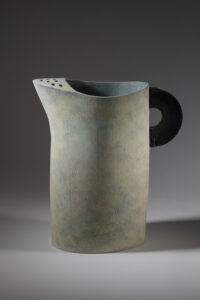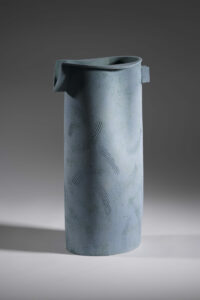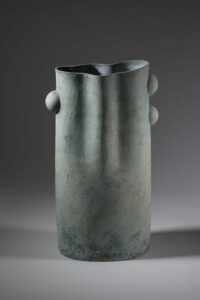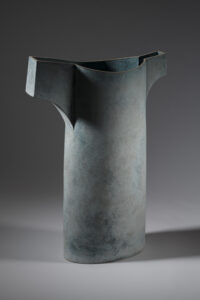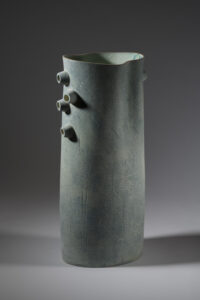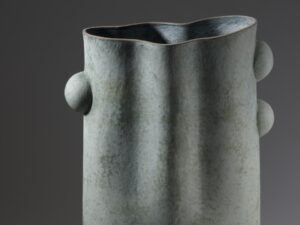
Annually, the Liverpool Irish Festival sets a theme and a creative brief.
We work with partners to develop work and engage artists. Bluecoat Display Centre has been a key player in developing design and craft in Liverpool, nationally and internationally, since the 1950s. Who better then to partner with each year to find an Irish talent? Supported by the Design and Crafts Council of Ireland, we make an open call for makers to respond to the theme and our panel makes a selection from the submissions. Last year we chose ceramicist Rory Shearer, whose Derry based work evoked the hills and turf of his country pottery.
Even during Covid-19, 2020s submissions were of a high quality. Ordinarily, we would try not to pick the same medium year-on-year, but Mike’s application was tailored so well to the idea of exchange and he challenged notions of Irishness so well in his statement, he was the finalist. Below, Festival Director Emma Smith, quizzes Mike on some of the concepts raised, along with some probing questions in to the materiality of pottery, high and low culture and stars of the future.
ES: As I read through your submission statement, I noted your mention of Irishness as perceived via “the Irish/cottage/shamrock/American view”. For some Irish people, these values are an intrinsic part of their Irishness, not to be besmirched by the likes of curators/artists /‘intelligentsia’. For them, these items depict levity, light and charm, drawing on Irish traditions that can be taught from these symbolic snippets. Seen as positive, transportable commodities, they help people feel ‘at home abroad’, triggering memories of hills and faces; times and places. For others, it represents a low-taste-level and a (mis)mannered caricature; a nonsense version of a nuanced and deeply emotional national character. I read your view of such items as ‘tokenistic’; do you think there is a place for this or do they take or detract from an understanding of Irish people and their identity?
MB: I can see both sides of this argument; it does show levity, light and charm and appeals to Irish people abroad, particularly to those away a long time. It is an old fashioned, emotional look back at what they think they remember about Ireland. Apart from jumping around on a Saturday night in a Paddy hat, this is not a view taken seriously by Irish people at home and I do not think they represent contemporary Irish lives.
The EU, sojourns abroad for work or holiday, the digital age and a new prosperity have made Ireland a changed place; the old woman in the bed is no longer sipping porter, she is checking her emails.
I think these symbols/images are sort of harmless; there are new stories to tell and new ways to tell the old ones.
ES: Thinking through this brought to mind the William Morris idea that the destruction of capitalism would be necessary for art to flourish! This positioning of ‘low’ and ‘high’ art or culture seems frequently tied to concepts of Irishness, as demonstrated by shamrocks and novelty hats versus the written word, traditional fabrics and making methods.Ceramics often sits in that liminal space between ‘crafts’ and ‘arts’ with similar arguments surrounding it as having high and/or low cultural value. What are your thoughts?
MB: I think there is a place for this material. As you said, it is a bit of fun and I can’t imagine it is taken too seriously. But take a new initiative: ‘The Wild Atlantic Way’; a notion that comes from the same emotional gene pool as the other material is a great success, eagerly embraced by all. I think this is a fine example of a modern take on this question.
If -when I was a tutor in Art school- a student expressed a desire to make products for the tourist trade (some explored niche ideas such as hill walking), I would advise them not to overlook the sentimental pull of certain ideas and clichés and to look at them from a slightly different angle adding a more contemporary slant to them.
I think a lot of the old representation of Ireland does not represent Ireland today, but I would not be beating my breast about it. It has changed from longed-for nostalgic memory to a bit of fun. There is a travel company here called The Paddy Wagon; it takes young foreign backpackers around Ireland. They wear the hats, sing the songs and they give them all the old blarney; they love it. On the other hand, the proliferation of shops in tourist spots -and in the major cities- selling Guinness merchandise (almost exclusively), little of it made in Ireland, can be disheartening.
Yes, Ceramics is in an interesting position. Somewhere in the half-light between craft, design, the decorative arts and art, but it is quite easy to position the various strands. Intent is all! The craft potter makes domestic ware; the designer designs for the industry; the decorative arts have their conventions and artists deal with many issues including social and aesthetic. The only common denominator is the material and the processes. Some see it as a kind of hierarchy. We all need someone to look down on!
ES: The materiality of ceramics seems to be part of what locates them. Would your work would be the same if you were making it with Mexican barro negro or Chinese kaolin? I don’t just mean the overall finish or surface aesthetic, but in the forms it leads you to? One cannot do with terracotta what can be done with porcelain, so does Irish clay imbue the sculptural form innately and does its historic content play any part in the form you take it to? Is there an exchange in this process between artist and material?
MB: In my case, the concept comes first. The material is of course considered, insofar as it can do what the concept demands. Makers will choose a particular material like porcelain for what it will bring to the expressive outcome. As we don’t have exploitable clay deposits here, I use clay from Northern Ireland, where it is made using imported materials from the UK and beyond. It suits my work process well. It is a robust utility body, ideally suited to forms I make and the low firing temp I require. I cannot say that this particular clay influences my work conceptually.
ES: Ceramics have a role in all lives. It is likely that the nationality of the item is less important than the value of its aesthetic, function or place in a user’s world. Therefore, should Irishness play any part on the form and does it require such a connection?
MB:I never think of myself, or my ideas, as being Irish while I am making. Ideas come and develop as things get made and are appraised. It is a never-ending chain of exploration, frustration and a little joy. I live in a small city near the west coast of Ireland. I travel up and down the coast often. I draw the landscape, collect objects; manmade and natural. I feel close to Ireland and am happy to be Irish and I am sure that this life influences how and what I make. I think attempting to build Irishness into the form would be a contrivance and could possibly muddy the waters in the creative expression or interpretation of the concept.
ES: Are there any rising stars in Irish ceramics you think we/audiences ought to look out for?
MB: Frances Lambe, Sara Flynn, Mandy Parslow, Grainne Watts, Alison Kay and Nuala O’Donovan.
We would like to offer Mike our sincere thanks and congratulations for being involved in this year’s In The Window and recommend any Irish maker look out for our new artistic call in 2021. See more of Mike’s work here or visit his work in the real world at Bluecoat Display Centre from 1-31 Oct 2020. His statement is below the gallery for those who wish to know ore about this particular project.
This is exhibit is supported by the Design and Crafts Council of Ireland.
STATEMENT: Exchange
When in art school in the 1970’s, ceramic design students we were desperately trying to shed the Irish/cottage/shamrock, Irish/American view and imagery of Ireland, which dominated tourist products and literature at the time. The tourist market then far outweighed the domestic market for craft and design products and so, could not be ignored. While quality Irish craft and ceramics has developed in the intervening years, it has done so alongside a combination of persisting staged Irish product offerings and a secondary -perhaps more thoughtful, but still shallow- emblematic or caricature-like selection of products that outsells art and craft ceramics. So today’s stories, as far as products representing and reflecting Irish culture are concerned -it seems to me- fall into two categories: firstly, those that are driven by and trade on associations and imagery of a notion of Irishness or Irish tradition -for example reproduction Celtic iconography, Guinness t-shirts, visual representations of animals, landscape, Irish colloquialisms etc., on products and in prints; and –secondly- those stories that emerge through work that is conceived and produced by creative Irish individuals; stories and artefacts that carry with them an authenticity that finds a different type of audience; smaller, more focused; recognising Irish origin, but more concerned with the underlying ideas rather than with Irish tokenism.
At the time I studied at Limerick School of Art and Design all the tutors of ceramics were English and brought with them a long tradition of ceramic making from Medieval pottery to the factories of Stoke-on-Trent. The Irish do not have a continuous history of ceramics, and with British involvement in Ireland for so long, imported English ceramics became as common in Ireland as in any other part of these islands. So, the English tradition became the Irish tradition, prized cream jugs in our grandmothers’ dressers all carried the great Stoke trademarks. The diasporic exchange was essentially one-way. However, as students graduated from art, craft and design courses in Ireland over the decades since the 1970’s, they slowly began to develop and create identities for themselves through their output. It is difficult to argue there is any consistent cultural theme running through this work, least of all a particularly Irish one. However, it is true to say that that educational exchange in art and design, which occurred as a result of the developing Irish creative education institutions hiring staff from outside Ireland, had a deep and lasting impact. This exchange is now no longer one-way, as Irish artists, designers and craftspersons who benefited from the input of international educators, achieve success at home and abroad.
In an effort to boost the development of design and craft -and almost concurrent with the arrival of international educators into Irish creative third level education- the Irish Government established the Kilkenny Design Workshops (1963). Its aim was to improve the quality of Irish design. Each department of this design and development agency, including ceramics (where I was initially placed), was led by a designer from outside Ireland. I spent two years working at KDW and mixed with a wide range of designers in different fields from diverse backgrounds. It was very interesting to see how they, as designers, brought their experience and culture to bear on the work they did in Ireland. This exchange positively impacted a slew of young Irish creatives and contributed to a significant amount of the creative capability manifest in current Irish design.
Later, I taught on a ceramic design course. My students and I wrestled with the problem of Irishness in design, how to make work that felt like it came from Ireland yet looked beyond these shores to a modern Europe. Scandinavia was an obvious model where they used traditional materials, a combination of new and old processes and centuries of design development. However, it became clear that the quest to imbue our work with “Irishness” was not a premise upon which creative work could be based. Irishness, if it was something that could be a feature of a product or artwork (I personally doubt that it can be), would have to emerge through the work over a sustained period of time, through bodies of work by Irish artists, designers and craftspersons. After many years, I can say that I see enormous creativity, artistry, and superb craftsmanship all around, but it is hard to pin down a sense of Irishness in the work produced in Ireland. Clearly, in fine art -where Irish themes and landscape are the subject matter- there is a fundamental Irish connection. Some craft brands have become strong Irish brands such as Nicholas Mosse Ceramics, which draws on Irish flora and fauna themes in its decorative motifs.
One area where perhaps there have been significant international exchanges through traditional Irish design may have been in the textiles sector. In the emerging Ireland of the 1950’s, woven products from Ireland -Donegal Tweed, Foxford Woollens, Aran sweaters- had an international impact (especially in the United States). This exchange has continued to the present day and the cultural element -Irish traditional apparel and textiles- has found new connections and markets alongside its older markets. The “Irishness” of these products, unlike that of more recent design and craft output in Ireland, is, as in the case of the Scandinavian tradition, rooted in local materials and processes.
In my own work, sometimes intentional, sometimes accidental, my exploration of surface texture and colour seems to reflect the world around me. I believe that land and seascapes local to me, and unique to Ireland, drive the decision-making process that I use to build up the surfaces of my ceramics. Insofar as these surfaces derive their nature and energy from the influences surrounding me, they certainly reflect my Irishness.
The forms I have been making for some time now, upon which the above surfaces are developed, also have a certain Irish connection. Common domestic shapes such as pitchers, metal jugs and pourers have been creative resources for the shapes I have produced and new shapes that are evolving.
In conclusion, the exchange that took place during my education at LSAD and subsequently at Kilkenny Design Workshops has had a long lasting and deep influence on my work. What I make now, although it falls between utility and art, is neither. Yet it has its roots in my training, and in the influences of those I met from other cultures, during my education. As I exhibit at home and abroad, a new exchange is taking shape for me and informs my ongoing work.

